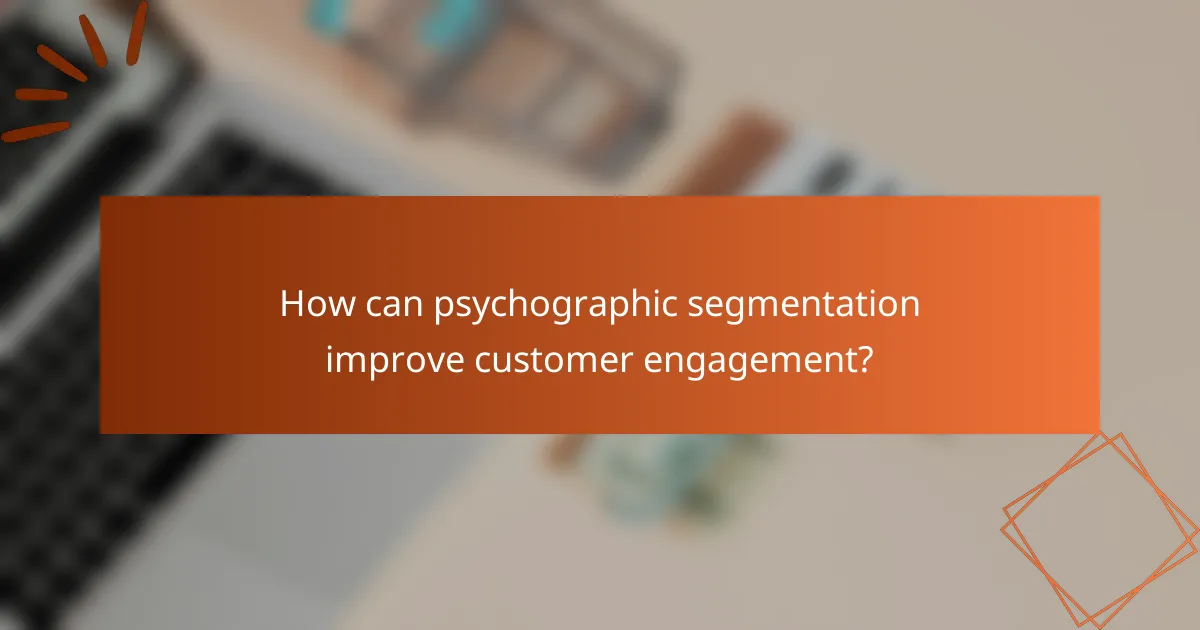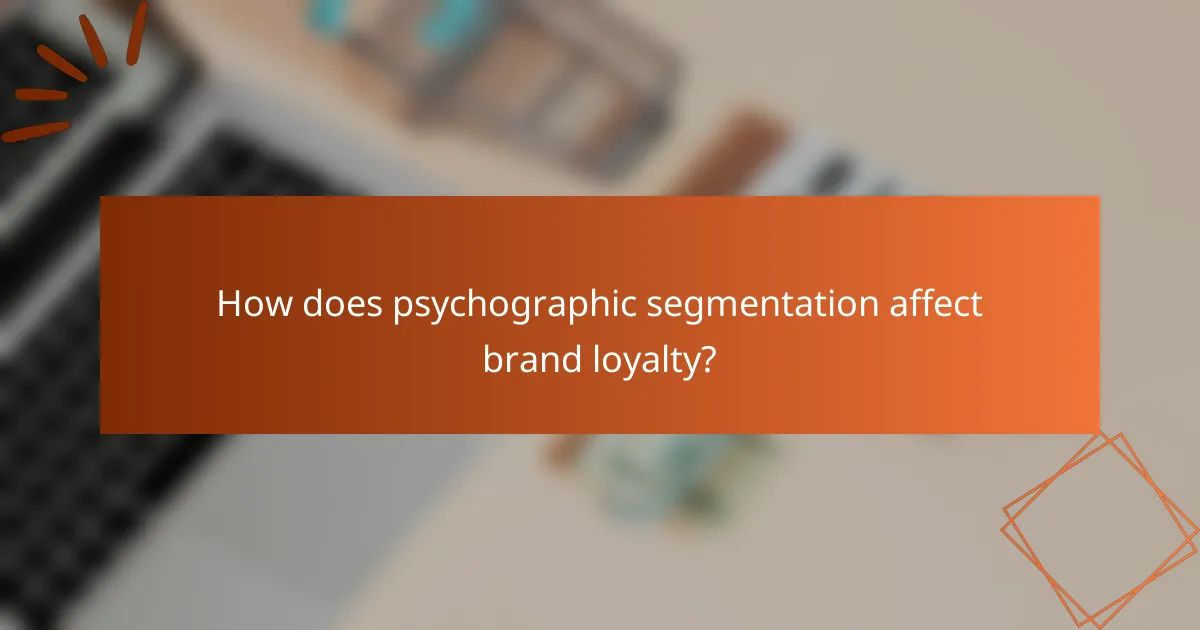Market research services that focus on psychographic segmentation provide valuable insights into consumer behavior by categorizing individuals based on their interests, values, and lifestyles. By understanding these deeper motivations, businesses can enhance customer engagement and foster brand loyalty through personalized experiences that resonate with their target audience.

How can psychographic segmentation improve customer engagement?
Psychographic segmentation enhances customer engagement by categorizing consumers based on their interests, values, and lifestyles. This approach allows businesses to create more personalized experiences that resonate with their target audience, fostering deeper connections and loyalty.
Identifying customer motivations
Understanding customer motivations is crucial for effective engagement. By analyzing psychographic data, businesses can uncover what drives their customers’ purchasing decisions, such as personal values, lifestyle choices, and emotional triggers. For example, a brand selling eco-friendly products can target environmentally conscious consumers by emphasizing sustainability in their messaging.
Utilizing surveys, focus groups, and social media insights can help identify these motivations. Regularly updating this information ensures that businesses remain aligned with evolving consumer preferences.
Tailoring marketing strategies
Once customer motivations are identified, businesses can tailor their marketing strategies accordingly. This could involve creating targeted campaigns that speak directly to the specific interests and values of different segments. For instance, a fitness brand might develop distinct marketing messages for health enthusiasts versus casual gym-goers.
Employing personalized content, such as targeted emails or social media ads, can significantly enhance engagement rates. It’s essential to test various approaches and refine strategies based on customer feedback and engagement metrics.
Enhancing product development
Psychographic segmentation also plays a vital role in product development. By understanding the preferences and lifestyles of their target audience, companies can design products that meet specific needs. For example, a tech company might create a gadget that appeals to tech-savvy millennials by incorporating trendy features and sleek designs.
Engaging with customers during the development phase through feedback loops can ensure that the final product aligns with their expectations, increasing the likelihood of market success.
Increasing customer retention
Improving customer retention is another benefit of psychographic segmentation. By continuously engaging customers based on their values and interests, businesses can foster loyalty. For instance, loyalty programs that reward customers for their specific preferences can enhance their overall experience and encourage repeat purchases.
Regular communication, such as personalized newsletters or exclusive offers, keeps customers informed and connected. Monitoring retention metrics and adjusting strategies based on customer behavior can further strengthen these relationships.

What are the best practices for implementing psychographic segmentation?
Implementing psychographic segmentation effectively involves understanding consumer motivations, preferences, and behaviors. Best practices include conducting thorough research, leveraging data analytics, and focusing on lifestyle and values to create targeted marketing strategies.
Conducting in-depth surveys
In-depth surveys are crucial for gathering qualitative insights into consumer attitudes and motivations. These surveys should include open-ended questions that allow respondents to express their thoughts and feelings, providing richer data than standard multiple-choice formats.
Consider using a mix of online and offline methods to reach diverse demographics. Aim for a sample size that reflects your target market, ensuring that the data collected is representative and actionable.
Utilizing data analytics tools
Data analytics tools play a vital role in processing and interpreting survey results and other consumer data. These tools can help identify patterns and trends that inform psychographic profiles, allowing businesses to tailor their marketing efforts effectively.
Utilize platforms that offer segmentation capabilities, such as Google Analytics or specialized CRM software. Regularly update your data to maintain accuracy and relevance, and consider integrating social media analytics for a broader view of consumer behavior.
Segmenting based on lifestyle and values
Segmenting consumers based on lifestyle and values involves categorizing them according to shared interests, beliefs, and behaviors. This approach allows for more personalized marketing strategies that resonate with specific consumer groups.
To implement this, create detailed personas that reflect the various segments within your audience. For example, a brand targeting eco-conscious consumers might focus on sustainability and ethical sourcing in its messaging, while a luxury brand may emphasize exclusivity and status.

How does psychographic segmentation affect brand loyalty?
Psychographic segmentation significantly enhances brand loyalty by aligning products and marketing strategies with consumers’ values, interests, and lifestyles. This alignment fosters deeper emotional connections, making customers more likely to remain loyal to a brand that resonates with their identity.
Building emotional connections
Emotional connections are crucial for brand loyalty, as they create a sense of belonging among consumers. Brands that understand their customers’ psychographics can craft messages that evoke feelings, leading to stronger attachments. For example, a brand that promotes sustainability may attract environmentally conscious consumers, fostering loyalty through shared values.
To build these connections, brands should use storytelling that reflects their customers’ aspirations and challenges. Engaging narratives can turn a simple transaction into a meaningful experience, encouraging repeat purchases.
Creating personalized experiences
Personalized experiences enhance customer satisfaction and loyalty by making consumers feel valued. By leveraging psychographic data, brands can tailor their offerings, from product recommendations to marketing communications, ensuring relevance to individual preferences. For instance, a fitness brand might offer personalized workout plans based on a customer’s lifestyle and fitness goals.
Implementing personalization strategies can involve using customer data analytics to segment audiences effectively. Brands should focus on creating targeted campaigns that speak directly to the interests and needs of specific groups, increasing engagement and loyalty.
Fostering community engagement
Community engagement is vital for reinforcing brand loyalty through shared experiences and interactions among customers. Brands that create platforms for community interaction, such as forums or social media groups, can strengthen bonds among users. This sense of community encourages customers to advocate for the brand, further enhancing loyalty.
To foster community engagement, brands should actively participate in discussions and provide valuable content that resonates with their audience’s interests. Organizing events or challenges can also help build a loyal community, as customers feel more connected to both the brand and each other.

What tools can assist with psychographic segmentation?
Several tools can effectively assist with psychographic segmentation by gathering and analyzing data on consumer behaviors, preferences, and values. These tools enable businesses to tailor their marketing strategies to enhance customer engagement and brand loyalty.
Qualtrics for survey design
Qualtrics is a powerful platform for designing and conducting surveys that capture psychographic data. It allows businesses to create customized questionnaires that can probe deeper into consumer motivations, attitudes, and lifestyles.
When using Qualtrics, focus on crafting questions that are clear and engaging to maximize response rates. Consider using a mix of quantitative and qualitative questions to gain a comprehensive understanding of your audience.
Google Analytics for data tracking
Google Analytics is essential for tracking user behavior on websites, providing insights into how consumers interact with your brand. It helps identify patterns in user engagement, which can be correlated with psychographic segments.
Utilize Google Analytics to monitor metrics such as session duration and bounce rates, which can indicate the effectiveness of your content in resonating with different psychographic profiles. Regularly review this data to adjust your marketing strategies accordingly.
HubSpot for customer relationship management
HubSpot offers a robust customer relationship management (CRM) system that helps businesses manage interactions with customers and prospects. It allows for segmentation based on psychographic data, enabling targeted marketing efforts.
Leverage HubSpot’s features to track customer interactions and preferences, ensuring that your communications align with their values and interests. This targeted approach can significantly enhance customer engagement and foster brand loyalty over time.

What are the key metrics for measuring customer engagement?
Key metrics for measuring customer engagement include Net Promoter Score (NPS), Customer Lifetime Value (CLV), and Engagement Rate. These metrics provide insights into customer satisfaction, loyalty, and the effectiveness of marketing strategies.
Net Promoter Score (NPS)
Net Promoter Score (NPS) gauges customer loyalty by asking how likely customers are to recommend a brand to others, typically on a scale from 0 to 10. Customers are categorized into promoters, passives, and detractors based on their responses, which helps businesses understand their overall customer sentiment.
A high NPS indicates strong customer loyalty and satisfaction, while a low score suggests areas for improvement. Regularly tracking NPS can help identify trends over time and assess the impact of changes in products or services.
Customer Lifetime Value (CLV)
Customer Lifetime Value (CLV) estimates the total revenue a business can expect from a single customer throughout their relationship. This metric helps businesses understand how much they can invest in acquiring and retaining customers while maintaining profitability.
To calculate CLV, consider average purchase value, purchase frequency, and customer lifespan. A higher CLV suggests that a customer is more valuable, allowing businesses to tailor their marketing strategies accordingly to enhance customer engagement and loyalty.
Engagement Rate
Engagement Rate measures how actively customers interact with a brand’s content, products, or services. This can include metrics such as likes, shares, comments, and time spent on a website or app. A higher engagement rate indicates that customers find the content relevant and appealing.
To improve engagement rates, businesses should focus on creating high-quality, relevant content that resonates with their target audience. Regularly analyzing engagement metrics can help identify successful strategies and areas needing adjustment to foster deeper customer connections.

How can businesses in the US leverage psychographic segmentation?
Businesses in the US can leverage psychographic segmentation by understanding the values, interests, and lifestyles of their customers. This approach allows companies to tailor their marketing strategies and product offerings to better meet the specific needs of different consumer groups.
Targeting niche markets
Targeting niche markets involves identifying and focusing on specific segments of the population that share distinct characteristics and preferences. By utilizing psychographic segmentation, businesses can create targeted marketing campaigns that resonate with these groups, leading to higher engagement and conversion rates.
For example, a company selling eco-friendly products can target environmentally conscious consumers by highlighting sustainability in their messaging. This focused approach not only attracts loyal customers but also enhances brand loyalty as consumers feel a deeper connection to brands that align with their values.
To effectively target niche markets, businesses should conduct thorough research to understand the psychographics of their audience. This includes analyzing consumer behavior, preferences, and lifestyle choices to create tailored marketing strategies that speak directly to these segments.


